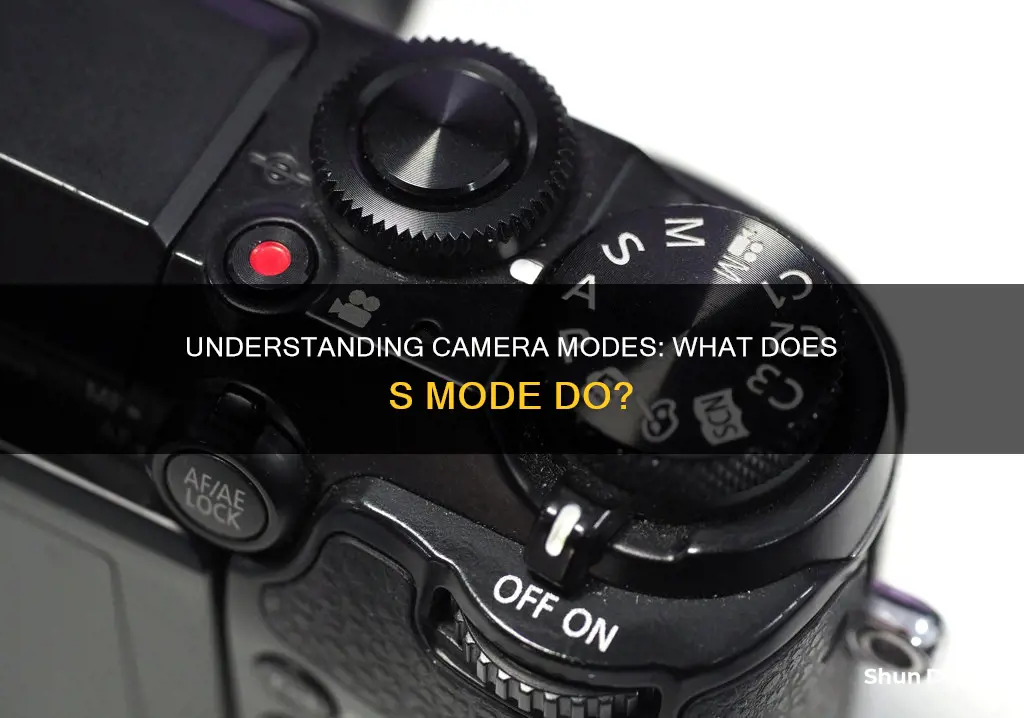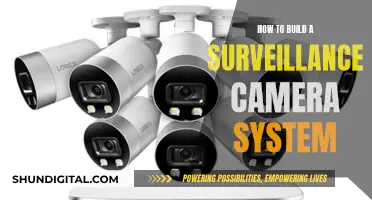
Understanding the different modes on your camera is essential to controlling the exposure in photography. While some cameras have more options than others, they all have a mode dial that determines how the camera will act when you point it at a scene. One of these modes is SP, which stands for Scene Position. This mode offers a choice of scenes, each adapted to particular shooting conditions or a specific type of subject. For example, you can choose the portrait scene for a smooth skin effect when shooting portraits, or the sports scene when photographing moving subjects.
| Characteristics | Values |
|---|---|
| Camera mode | SP mode |
| Purpose | Offers a choice of "scenes", each adapted to particular shooting conditions or a specific type of subject |
| Scenes | Portrait Enhancer, daylight shots of buildings and landscapes, moving subjects, poorly lit twilight or night scenes, fireworks, sunrises and sunsets, snow, beaches, indoor background lighting, flowers, text or drawings in print |
What You'll Learn

Shutter Priority (Tv) or (S)
Shutter Priority mode, often denoted by "Tv" or "S", is a semi-automatic shooting mode that allows photographers to manually set their desired shutter speed while leaving the camera to automatically adjust the aperture (f-number) to achieve optimal exposure. This mode is particularly useful when capturing moving subjects, as it enables photographers to "freeze" or create motion blur effects by selecting fast or slow shutter speeds, respectively.
In Shutter Priority mode, the photographer decides on the shutter speed, and the camera adjusts the aperture accordingly. The range of available shutter speeds varies between different camera models. By observing the subject's movements, photographers can choose whether to capture a crisp, static image or introduce motion blur to convey a sense of speed and movement.
When using a slow shutter speed, more light enters the camera sensor, making it suitable for shooting in low-light conditions or capturing light trails from moving vehicles or aircraft. Conversely, a fast shutter speed is ideal for sports and wildlife photography when capturing subjects in motion without blur, such as athletes or birds in flight.
Shutter Priority mode is a valuable tool for photographers who want to control the shutter speed while delegating the aperture selection to the camera. It provides a balance between full manual control and fully automatic modes, allowing photographers to focus on capturing dynamic moments without worrying about adjusting multiple settings simultaneously.
It's worth noting that Shutter Priority mode may result in overexposed or underexposed images if the available light is insufficient or if the selected shutter speed is too high or low, respectively. Photographers should also be cautious when using slow shutter speeds handheld, as it can lead to camera shake and blurry images.
Shipping Camera with Battery: Europe-Specific Guide
You may want to see also

Aperture Priority (Av) or (A)
In Aperture Priority mode, photographers can manually select the desired aperture (f-stop) to control the depth of field and achieve the desired amount of background blur. The camera then calculates and selects the appropriate shutter speed based on the available light to ensure a properly exposed image. This mode is advantageous when photographers want to prioritise controlling the depth of field over shutter speed.
Aperture Priority is a popular choice among photographers because it offers a balance between creative control and shooting speed. It allows photographers to work efficiently, especially in situations with changing light conditions, as they only need to adjust the aperture while the camera handles the shutter speed. This mode is commonly used in various photography genres, including landscapes, portraits, sports, wildlife, and events.
By using Aperture Priority, photographers can quickly adapt to different shooting scenarios without worrying about making manual adjustments to shutter speed. This mode ensures correct exposure while providing creative control over the depth of field, making it a versatile and preferred choice for many photographers.
Understanding Panasonic's RAW File Extension for Lumix Cameras
You may want to see also

Program mode
While in Program mode, you can also adjust other camera settings such as exposure compensation, white balance, metering mode, point of focus, and whether to use the flash. This mode gives you the flexibility to experiment with different settings without having to worry about manually adjusting the shutter speed and aperture for each shot.
However, it's important to note that Program mode may not always be the best choice. If you want more control over the shutter speed or aperture, you might want to switch to one of the Priority modes or Manual mode. Nonetheless, Program mode is a valuable tool for photographers who want a balance between automation and creative control.
Charging the Polaroid Spectra System Camera: A Step-by-Step Guide
You may want to see also

Manual mode
ISO controls your camera’s sensitivity to light. The higher the ISO, the noisier your photos become. So, if you are shooting at night and your shots are turning out too dark, you can boost your ISO to instantly brighten up your images. Conversely, if you are shooting on a sunny day and want to reduce your exposure, you can drop the ISO to achieve a darker result.
Aperture is an opening in the lens. The wider the aperture, the more light it lets in, and the brighter the resulting exposure. Aperture is also responsible for controlling the depth of field – the window of focus within the photograph. The larger the aperture, the smaller the depth of field, and the narrower the window of focus.
Shutter speed is the exposure time of an image; that is, it refers to how long the shutter stays open to allow light to hit the sensor. Therefore, the faster the shutter speed, the less light that hits the camera sensor, and the darker the final image. The shutter speed also determines image sharpness. A fast shutter speed will generally freeze the action, while a slow shutter speed will often produce motion blur.
Prolong Your Camera's Battery Life: Tips and Tricks
You may want to see also

Creative Automatic Mode
Creative Auto Mode is a setting available on most cameras that gives the photographer a balance between full manual control and full automatic control. In this mode, the camera automatically adjusts the shutter speed and aperture to suit the scene being photographed. However, the photographer can still manually adjust other settings like picture style, motor drive, and file format (e.g. RAW or JPEG).
Creative Auto Mode is a great option for photographers who want to focus on the creative aspects of photography without being overwhelmed by the technical details. It allows them to capture the moment without worrying about missing a shot due to incorrect settings. This mode is particularly useful for beginners who are still learning about the different settings on their camera and the effects they have on their photographs.
While Creative Auto Mode provides a good balance of control and automation, it is important to note that it may not always produce the exact results the photographer intends. This is because the camera makes certain creative decisions on its own, such as the aperture, shutter speed, and ISO. These decisions may not always align with the photographer's artistic vision. Therefore, Creative Auto Mode is best suited for situations where the photographer prioritizes convenience and speed over having full control over the technical aspects of the image.
Creative Auto Mode is just one of the many creative modes available on most cameras. Other common creative modes include Portrait Mode, Landscape Mode, Macro Mode, and Action/Sports Mode. Each of these modes is designed to optimize the camera's settings for a specific type of photography. For example, Portrait Mode will select a large aperture to create a shallow depth of field, blurring the background and bringing the subject into focus. On the other hand, Landscape Mode will use a small aperture to ensure that everything from the foreground to the horizon is in focus.
In conclusion, Creative Auto Mode is a valuable tool for photographers who want to strike a balance between manual and automatic control. It allows photographers to focus on their creative vision while still providing some flexibility to adjust certain settings. By using this mode, photographers can capture memorable shots without being bogged down by the technical intricacies of photography.
Mastering Batch Editing in Camera Raw: A Step-by-Step Guide
You may want to see also
Frequently asked questions
SP mode stands for "Scene Position" mode. It allows the user to select from a variety of "scenes", each adapted to particular shooting conditions or a specific type of subject. For example, "Portrait Enhancer" for a smooth skin effect when shooting portraits, "Classic Chrome" for daylight shots of buildings and landscapes, "Action" for photographing moving subjects, and "Night" for poorly lit twilight or night scenes.
To select SP mode on your camera, first rotate the mode dial to SP. Then, press MENU/OK while the mode description is displayed. If the view through the lens is displayed in the LCD monitor, press MENU/OK and select SCENE POSITION in the shooting menu. Finally, highlight your desired scene option and press MENU/OK.
SP mode is useful when you want to quickly adapt your camera settings to specific shooting conditions or subjects. For example, if you are photographing a portrait, you can select the "Portrait" scene in SP mode to automatically apply settings that will enhance your image. Similarly, if you are shooting at night, you can select the "Night" scene to optimize your camera for low-light conditions.







